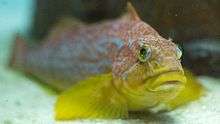Kelp greenling
Hexagrammos decagrammus, the kelp greenling, is a species of greenling that occurs in rocky nearshore areas of the northern Pacific especially around British Columbia and Alaska, and is common on kelp beds and on sand bottoms. They feed on crustaceans, polychaete worms, brittle stars, mollusks, and small fishes. The young are food for large predators such as lingcod and halibut. Unique to this species is its mating ritual, where males attempt to inseminate eggs in the nests of other males. This phenomenon can be explained with condition dependent mating decisions.[1]
| Kelp greenling | |
|---|---|
.jpg) | |
| Hexagrammos decagrammus (male) | |
| Scientific classification | |
| Kingdom: | |
| Phylum: | |
| Class: | |
| Order: | |
| Family: | |
| Genus: | |
| Species: | H. decagrammus |
| Binomial name | |
| Hexagrammos decagrammus (Pallas, 1810) | |
.jpg)
Fishing

This species is frequently caught by hook and line, fishing from shore or skiff, as well as speared by divers. They are commonly caught by fishermen targeting other species, and are often viewed as pests, despite their scrappy fight and tasty flesh. They are easily caught around rocky cliffs and kelp beds, and respond to a wide variety of natural and artificial baits.
References
- Freiwald, Jan (Winter 2009). "Isolation and characterization of nine polymorphic microsatellite loci of the kelp greenling, Hexagrammos decagrammus, a temperate reef fish". Molecular Ecology Resources. 9 (2): 563–565. doi:10.1111/j.1755-0998.2008.02371.x.